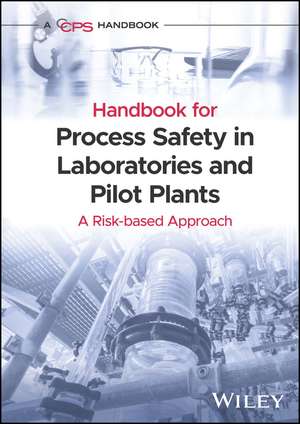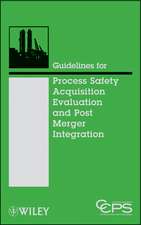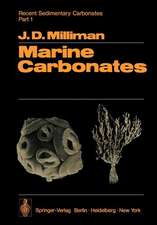Handbook for Process Safety in Laboratories and Pilot Plants – A Risk–based Approach
Autor CCPSen Limba Engleză Hardback – aug 2023
Preț: 946.83 lei
Preț vechi: 1245.83 lei
-24% Nou
Puncte Express: 1420
Preț estimativ în valută:
181.18€ • 193.74$ • 151.06£
181.18€ • 193.74$ • 151.06£
Carte disponibilă
Livrare economică 28 martie-11 aprilie
Livrare express 13-19 martie pentru 51.83 lei
Preluare comenzi: 021 569.72.76
Specificații
ISBN-13: 9781119010135
ISBN-10: 1119010136
Pagini: 560
Dimensiuni: 178 x 254 x 29 mm
Greutate: 1.13 kg
Editura: Wiley
Locul publicării:Hoboken, United States
ISBN-10: 1119010136
Pagini: 560
Dimensiuni: 178 x 254 x 29 mm
Greutate: 1.13 kg
Editura: Wiley
Locul publicării:Hoboken, United States
Public țintă
The target audiences include engineering and scientific professionals, technical support staff and management involved with chemical laboratory and pilot plant research and development (R&D) activities in: chemical process industry companies that develop and/or manufacture chemical products, materials, fuels; chemical process equipment and/or process technology suppliers; contract or toll chemical manufacturers; other industrial R&D users of hazardous materials outside the traditional chemical process industry categories;Universities (e.g. those in chemical engineering departments–– faculty, students and technical support staff; those in other chemical and materials sciences departments involved with use of hazardous materials in process and product research)
Government laboratories (e.g. those in DOD and DOE laboratories involved with use of hazardous materials in process and product R&D programs)
Descriere scurtă
Notă biografică
Cuprins
List of Figures x List of Tables xi Abbreviations and Acronyms xii Glossary xv Acknowledgments xxii Dedication xxiv Online Materials Accompanying this Handbook xxv Preface xxvii Part 1 - Introduction and Overview 1 1 Purpose and Scope 3 1.1 Purpose 3 1.2 Scope of Book and Target Audience 4 1.3 Terms for Laboratories and Pilot Plants 5 1.4 Distinctions between Laboratories and Pilot Plants 7 1.5 Organization of This Handbook 8 2 Managing Risk to Prevent Incidents 13 2.1 Some LAPP Characteristics 13 2.2 Safety in Laboratories and Pilot Plants 24 2.3 Where to Start with a Risk-based Approach in the LAPP 25 2.4 Gain Leadership Support to Implement Risk Based Process Safety 29 2.5 Laboratory Safety Management System Considerations 29 2.6 Resources for Risk Based Process Safety Management System 31 3 Leaks and Spills in the LAPP 35 3.1 Leaks of Hazardous Materials 35 3.2 Spills of Hazardous Materials 38 Part 2 - Committing to Process Safety 39 4 LAPP Risk Management Concepts 41 4.1 Occupational Safety and Process Safety 41 4.2 Hierarchy of Controls 41 4.3 Inherently Safer Design (ISD) 42 4.4 Basic Risk Concepts 44 4.5 A Risk Management Program 47 4.6 Anatomy of an Incident 48 4.7 Preventive and Mitigative Safeguards 49 4.8 Applying a Risk-Based Approach in a LAPP 51 5 Process Safety Culture in the LAPP 55 5.1 RBPS Element 1: Process Safety Culture 55 5.2 Leaders' Responsibilities for Positive Safety Culture 58 5.3 Resources and Examples for Process Safety Culture 59 6 Standards for the LAPP 63 6.1 RBPS Element 2: Compliance with Standards 63 6.2 Risk Management Focus 65 6.3 Different Codes and Standards When Scaling Up from Laboratory to Pilot Plant 65 6.4 Jurisdictional Requirements 67 6.5 Resources for Compliance with Standards 67 7 Process Safety Competency and Training in the LAPP 69 7.1 RBPS Element 3: Process Safety Competency 69 7.2 RBPS Element 12: Training and Performance Assurance 72 8 Workforce Involvement and Stakeholder Outreach in the LAPP 79 8.1 RBPS Element 4: Workforce Involvement 79 8.2 RBPS Element 5: Stakeholder Outreach 82 Part 3 - Understanding Hazards and Risks 83 9 Process Safety Knowledge Management in the LAPP 85 9.1 RBPS Element 6: Process Knowledge Management 85 9.2 Overview of Information and Data Needs 86 9.3 Sources of Information and Data 89 9.4 Process Safety Information during Scale-up 92 10 Types of Hazards 95 10.1 Reactive Chemistry Hazards 95 10.2 Toxicity Hazards 115 10.3 Flammability and Combustibility Hazards 121 10.4 Temperature Hazards 137 10.5 Overpressure Hazards 140 10.6 Other Common LAPP Hazards 142 Table of Contents vii ix 11 Hazard Identification and Risk Analysis (HIRA) in the LAPP 153 11.1 RBPS Element 7: Hazard Identification and Risk Analysis 153 11.2 HIRA Team Members 156 11.3 HIRA Approaches Used in LAPPs 156 11.4 Qualitative versus Quantitative Analysis of Risks in LAPPs 165 11.5 ACS Hazard Analysis Tools 168 11.6 Evaluating the Effort Level for HIRAs 168 11.7 Determining the Extent of the HIRAs 169 Part 4 - Managing Risk: Engineered Controls 171 12 Spill and Leak Protection 173 12.1 Containment 173 12.2 Flexible hose and tubing 173 13 Fire and Over-Temperature Protection 175 13.1 Fire Prevention 175 13.2 Fire Mitigation 183 13.3 Over-Temperature Protection 185 14 Overpressure Prevention and Protection 191 14.1 Pressure Protection for Equipment 191 14.2 Pressure and Vacuum Relief for Atmospheric Pressure Vessels 196 14.3 Process Conditions/Situations to Consider in Pressure Relief Device Design 197 14.4 Blast Containment Cells and Pressure Relief for Building Areas 198 14.5 Venting Location and Downstream Treatment of Material Vented 201 15 Ventilation Controls 203 15.1 Ventilation Systems 203 15.2 Laboratory Chemical Fume Hoods 205 15.3 Pilot Plant Ventilation 207 15.4 Permanent Total Enclosures for Containment in the LAPP 207 16 Automated Shut-down Systems 209 16.1 Selection and Design Based on Hazard Identification and Risk Analysis 209 16.2 Basic Control Systems and Safety Shut-down Systems 209 16.3 Independent Automated Safety Shut-down Systems 210 16.4 Fail-Safe Design Considerations 212 16.5 Important Design Features for Control Systems 212 16.6 Control of Changes and Maintenance for Engineered Safeguards 214 16.7 Additional References 215 17 Engineered Controls for Common Hazards 217 17.1 Cryogenic Fluids and Compressed Gases 217 17.2 Cryogenic Fluids and Compressed Gas Cylinders 218 17.3 Glass Equipment 228 17.4 Gloveboxes 228 Part 5 - Managing Risk: Administrative Controls 235 18 Administrative Fire and Explosion Safeguards 237 18.1 Standards and Guidance for Fire Prevention 237 18.2 Ignition Source Control: Procedures 237 18.3 Manual Fire Suppression 238 19 Administrative Safeguards for Hazards in LAPPs 239 19.1 Good Practices for Compressed Gas and Cryogenic Cylinders 239 19.2 Regulations and Standards for Compressed Gases and Cryogenic Fluids 239 19.3 Procedures and Best Practices for Compressed Gases 241 19.4 Good Practices for Storage, Movement, and Use of Cryogenic Fluids 248 19.5 Good Practices For Handling Glass 251 19.6 Administrative Controls for Reactive Hazards 251 Part 6 - Managing Risk: RBPS Management Systems 253 20 Operating Procedures and Conduct of Operations in the LAPP 255 20.1 RBPS Element 8: LAPP Operating Procedures 255 20.2 RBPS Element 15: Conduct of Operations 260 21 Safe Work Practices and Contractor Management in the LAPP 263 21.1 RBPS Element 9: Safe Work Practices 263 21.2 RBPS Element 11: Contractor Management 266 22 Asset Integrity and Reliability in the LAPP 269 22.1 RBPS Element 10: Asset Integrity and Reliability 269 22.2 A Management Approach for Assuring Asset Integrity and Reliability 270 22.3 Examples of Asset Integrity and Reliability Management System Failures 271 22.4 Glass Equipment--Asset Integrity and Reliability Challenge for LAPPs 274 23 Management of Change (MOC) and Operational Readiness in the LAPP 277 23.1 RBPS Element 13: Management of Change 277 23.2 RBPS Element 14: Operational Readiness 281 Table of Contents ix xi 24 Emergency Management in the LAPP 283 24.1 RBPS Element 16: Emergency Management 283 24.2 Emergency Planning 283 24.3 Implementing an Emergency Management Plan 284 24.4 Emergency Equipment 285 24.5 Training and Drills 285 24.6 Deficiencies in Emergency Planning and Response in LAPP Cases 286 24.7 Controlling Unattended Experimental Work and Working Alone in LAPPs 288 Part 7 - Learning from Experience 291 25 Investigating Incidents 293 25.1 Incident Terminology 293 25.2 RBPS Element 17: Incident Investigation 294 25.3 Steps of an Incident Investigation 295 25.4 Ensure Lessons Are Learned and Remembered 298 25.5 Learn from Experience of Others 298 26 Metrics, Auditing, and Management Review in the LAPP 299 26.1 RBPS Element 18: Measurement and Metrics 299 26.2 RBPS Element 19: Auditing 300 26.3 RBPS Element 20: Management Review and Continuous Improvement 302 Part 8 - Conclusion 305 References 307 Appendix A Cases 323 Appendix B Examples 453 Appendix C Control Banding Strategies 501 Appendix D Glass Equipment Design 517 Index 525

















